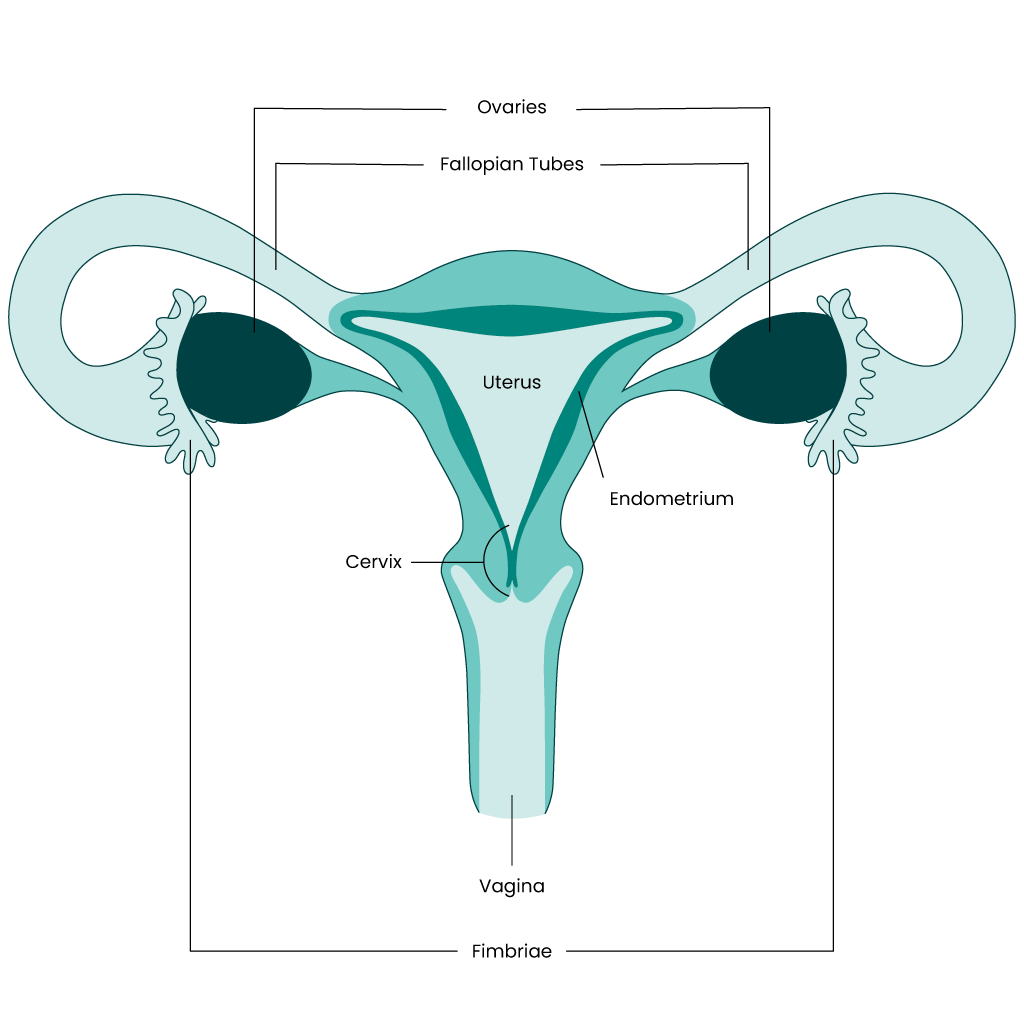Cancer is a term used to describe a group of diseases in which abnormal cells divide without control and can invade other tissue in the body.
The body is made up of many types of cells that grow and divide in a controlled way to produce more cells that are needed to keep the body healthy. When cells become old or damaged, they die and are replaced with new cells.
Sometimes the genetic material (DNA) of a cell becomes damaged or changed, producing mutations that affect normal cell growth and division. When this happens, cells do not die when they should, and new cells form when the body does not need them. The extra cells may form a mass of tissue called a tumour.
Ovarian cancer refers to a group of distinct cancers that originate at or near the ovaries.
Ovaries
Ovaries are reproductive glands found in females. Each female has two ovaries, located in the lower abdomen (belly), on each side of the uterus. The ovaries produce eggs (ova) for reproduction and the female hormones estrogen and progesterone.
Cells in the ovaries
The ovaries are made up of three main kinds of cells:
- Epithelial cells – these cells are found on the outer surface of the ovary.
- Germ cells – these cells are found inside the ovary, and form the eggs.
- Stromal cells – these cells form the structural tissue that hold the ovary together.
Each of these types of cells may develop into a different type of tumour.

Internal female reproductive anatomy
Ovaries
- Ovaries are reproductive glands found in females. Each female has two ovaries, and they are located in the lower abdomen (belly), on each side of the uterus. The ovaries produce eggs (ova) for reproduction and the female hormones estrogen and progesterone.
Fallopian tubes
- Fallopian tubes are sometimes called uterine tubes and they connect the uterus and ovaries. The egg (ovum) travels through these tubes to the uterus.
Uterus
- The uterus is sometimes called the womb. It is a hallow organ, shaped like a pear. It is where the fetus develops.
Endometrium
- The endometrium is the tissue that lines the inside of the uterus.
Cervix
- The cervix is a small canal between the top of the vagina and bottom of the uterus. It is about 4cm long and attaches the vagina to the uterus.
Vagina
- The vagina is sometimes called the birth canal. It is a muscular tube, or passageway, that goes from outside the body to the cervix.
Fimbriae
- The fimbriae are finger-like projections found at the ends of the fallopian tubes, near the ovaries. They play an important role in ovulation.
Types of ovarian cancer
It is very important to remember that ovarian cancer is not just one disease, it is a group of diseases.
Each type of ovarian cancer is different and are broadly classified according to which type of ovarian cell they start from (epithelial, germ, or stromal).
Ovarian tumours may be benign (not cancerous) or malignant (cancerous). Ovarian tumours that are malignant (cancerous) can spread (metastasize) to other parts of the body and can be serious.
Epithelial ovarian cancer is the most common type of ovarian cancer, making up approximately 85% – 95% of cases. It starts in the cells that cover the lining (or epithelium) of the fallopian tube or the ovary. Within this category of epithelial ovarian cancer, there are even more subtypes of ovarian cancer that should be treated as different types of cancer, rather than as one disease:
- Serous tumours: Serous refers to the serous membrane of the epithelium (outer layer of the ovary). Serous epithelial ovarian cancers tend to be diagnosed in later stages (Stages 3 or 4). There are two categories of serous epithelial ovarian cancers:
- High grade serous epithelial ovarian cancer: This is the most common subtype of ovarian cancer and accounts for up to 70% of all ovarian cancer cases. The majority of high-grade serous ovarian cancers originate in the fallopian tube, not the ovary, which offers important prevention opportunities.
- Low-grade serous epithelial ovarian cancer: This is the least common type of ovarian cancer, and as such, knowledge of this type of ovarian cancer is very limited. However, it is associated with younger age at diagnosis, slower growth, and is more likely to be resistant to chemotherapy.
- Clear cell carcinoma: This is the second most common type of ovarian cancer affecting approximately 10%-13% of cases. This type is often associated with endometriosis (a somewhat common and typically benign condition in which tissue similar to the endometrial lining inside the uterus grows outside the uterus). Clear cell carcinoma is often diagnosed in earlier stages (stages 1 or 2) and therefore has a better prognosis.
- Endometrioid tumours: This is the third most common type of ovarian cancer and is also believed to arise from endometriosis. Similar to clear cell, endometrioid tumours are often diagnosed in earlier stages (stages 1 or 2) and therefore have a better prognosis.
- Mucinous tumours: This affects approximately 3%-4% of individuals diagnosed with ovarian cancer. Most mucinous ovarian cancers are characterised by large masses. Removing these tumours is associated with a good prognosis.
- Undifferentiated or unclassified: In these cases, the cancer cells are undeveloped and therefore it is not possible to see where the tumour’s cells originated.
- Borderline ovarian tumours: These tumours are less likely to be malignant. They usually affect younger women, have a better cure rate than other types of tumours, and are treated only with surgery.
Approximately 5%-10% of ovarian cancer cases are germ cell tumours and start from germ cells (cells from which eggs are formed) within the ovaries. They can occur in people at any age but tend to affect those in their twenties. The sub-types are:
- Dysgerminoma: This is the most common type of germ cell ovarian cancer.
- Endodermal sinus tumours: This type of germ cell ovarian cancer is also called a yolk sac tumour. These are fast growing tumours and are more likely to affect young women.
- Immature ovarian teratoma: These are very rare ovarian cancers and are more likely to affect females under age 20. These are the most common ovarian tumours in children.
This is a very rare type of ovarian cancer beginning in the cells that hold the ovaries together. These cells produce female hormones. Therefore, stromal cell ovarian cancer is characterized by symptoms related to hormone production, for example, the appearance of facial hair, infrequent menstrual periods, menstrual periods after menopause, and a hoarse voice. These tumours generally occur in younger individuals and are found in earlier stages, therefore having a higher survival rate.
Fallopian tube cancer and primary peritoneal cancer are now considered types of ovarian cancers.
The fallopian tubes connect the ovaries to the uterus. The eggs (ova) travel from the ovaries through the fallopian tubes to the uterus. The peritoneum is the membrane that lines the inside of the abdominal cavity and the surface of all organs in the abdomen. Recently, pathologists and oncologists now consider ovarian, fallopian tube and primary peritoneal cancers to be same disease, indistinguishable under the microscope and called by different names only because of differences in the distribution of the cancer. As such, symptoms and treatment are the same as for ovarian cancer.
Continue learning
Article
Grades of ovarian cancer
The grade of a tumour refers to how abnormal the tumour cells look under a microscope. It is an indicator of how quickly a tumour is likely to grow and spread. The more the cancer cells look like a normal cell, the more they will behave like a normal cell. Knowing the grade of a cancer helps the medical team to determine how effective a certain treatment may be.
Article
Stages of ovarian cancer
Staging is the process of finding out how widespread the cancer is within the body. If the cancer has spread, the stage describes how far it has spread from the ovaries to other parts of the body.
Article
Ovarian cancer risk factors
Everyone born with ovaries has some risk for ovarian cancer. Some people have higher risk than others based on a number of factors.
Abdullahi Idle, S., Hayes, K., & Ross, J. A. (2020). Ultrasound features of immature ovarian teratomas: Case series and review of literature. Ultrasound, 28(2), 82-90.
Babaier, A., Mal, H., Alselwi, W., & Ghatage, P. (2022). Low-Grade Serous Carcinoma of the Ovary: The Current Status. Diagnostics, 12(2), 458.
Cancer Research UK (2021). Epithelial Ovarian Cancer. Retrieved: website link.
Centre for Disease Control and Prevention (2022). Lynch Syndrome. Retrieved: website link.
Cleavland Clinic (2021). Ovarian Germ Cell Tumours. Retrieved: website link.
Falzone, L., Scandurra, G., Lombardo, V., Gattuso, G., Lavoro, A., Distefano, A. B., … & Scollo, P. (2021). A multidisciplinary approach remains the best strategy to improve and strengthen the management of ovarian cancer. International Journal of Oncology, 59(1), 1-14.
Łuczak, J., & Bagłaj, M. (2018). Ovarian teratoma in children: a plea for collaborative clinical study. Journal of ovarian research, 11(1), 1-8.
Minnesota Ovarian Cancer Alliance (2022). Stromal Cell Ovarian Cancer. Retrieved: website link.
Morice, P., Gouy, S., & Leary, A. (2019). Mucinous ovarian carcinoma. New England Journal of Medicine, 380(13), 1256-1266.
Moujaber, T., Balleine, R. L., Gao, B., Madsen, I., Harnett, P. R., & DeFazio, A. (2022). New therapeutic opportunities for women with low-grade serous ovarian cancer. Endocrine-related cancer, 29(1), R1-R16.
National Cancer Institute (2022). Ovarian Germ Cell Tumors Treatment (PDQ®)–Patient Version. Retrieved: website link.
Reid BM, Permuth JB and Sellers TA: Epidemiology of ovarian cancer: A review. Cancer Biol Med. 14:9–32. 2017.
World Health Organization (2021). Endometriosis. Retrieved: website link.


